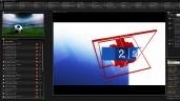TV2 Norway tests cost-effective 3-D distribution over IP

Broadcasters are beginning to realize new ways of distributing 3-D content without having to spend a lot of money and effort. This weekend, TV2 Norway, the country’s largest commercial television station, broadcast a live football (soccer) game using an IPTV stream and stereoscopic conversion technology from SterGen, a Vizrt partner company.
TV2 Norway broadcast a Barclays Premier League match between Manchester United and Liverpool, sending a 2D feed, which was then converted to 3-D for viewing over an IPTV infrastructure (Internet-connected TVs) and over the web.
The setup included receiving the live feed via satellite and then running it through a Digital Rapids live encoder. SterGen’s 2D-to-3D conversion technology was then applied to overhead shots and distributed as an H.264-compressed file, using adaptive bit-rate streaming, and converted for display by Microsoft Silverlight-compatible players (supporting 3-D).
The expectation is that such high-profile sporting events will stimulate the sale of 3DTV sets, which executives at TV2 said are “rising rapidly.” TV 2 said it already has a “huge amount” of viewers watching football on its online platform (TV 2 Sumo).
“By running a game as big as Manchester United-Liverpool in 3-D online, a large number of our customers get to enjoy a revolutionary three-dimensional sports experience,” said Eva Iselin Husby, editorial manager at TV2 Sumo.
TV2 routed the 2-D signal captured live on site through SterGen’s live 2D to 3-D decoder, adjusting and applying the 3-D effect slightly differently for the PC and IPTV platforms. Another Vizrt partner, Vimond Media Solutions, helped to stream the 3-D content, giving TV2 the ability to augment its 2-D service with 3-D content viewable on connected Blu-ray consoles, connected TVs, desktop computers, tablets and other mobile devices. Viewers were able to watch the game either via a 3-D IPTV connected to the web or using a 3D-compatible PC screen using active shutter glasses.
SterGen’s patent pending algorithms — which support both active and passive shutter glasses — allow users to create computer-generated stereoscopic 3-D from individual 2D cameras or program feeds in real time. The technology augments the native 3-D content shot on the field with realistic-looking 3-D overhead views that the company says are most often used during a soccer match. It solves the native 3-D’s “camera flatness problem in the high cameras,” as a result of a physical limitation of the 3D cameras.
The professional video industry's #1 source for news, trends and product and tech information. Sign up below.
“With SterGen’s engine, every game that was shot in 2-D can be viewed as 3-D‚ giving the viewer a quality, genuine 3D experience,” said Ofer Wolf, chief executive officer at SterGen. “Using smart and smooth transitions of the 3-D effect between different scenes, the viewing experience is kept as comfortable as possible.”
He added that the conversion technology allows broadcasters to create the right 3-D effect to fit the different devices, “as the optimal effect to a tablet or a PC screen will differ from the one suitable for large TV screens.”
SterGen’s approach provides an attractive business model for 3DTV broadcasting, as it can repurpose existing 2D content and also cost-effectively produce live events in 3-D using less costly 2D equipment and crews.
As software-based image processing technology continues to get better, 2D to 3-D conversion techniques are becoming more attractive to producers looking to conserve costs. It’s clear that, for TV2 Norway, this could not have been done (economically) any other way.
